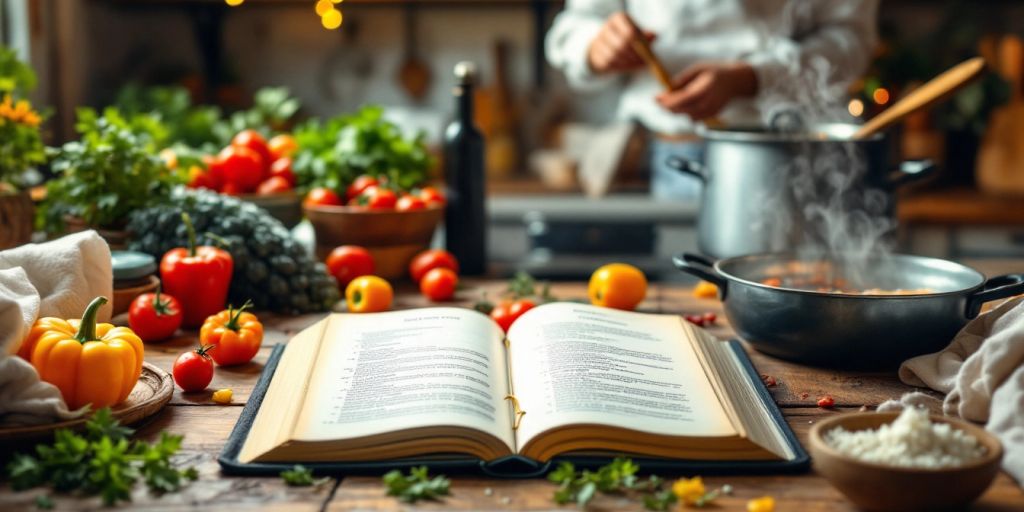Starting a recipe blog can be a fun and rewarding adventure. Whether you love cooking, baking, or just sharing your food experiences, this guide will help you get started on the right foot. We’ll cover everything from picking your niche to engaging with your audience, making sure you have all the tools you need to succeed in the blogging world.
Key Takeaways
- Find a specific area of cooking that excites you.
- Set small, achievable goals to stay motivated.
- Be yourself in your writing; your voice matters.
- Use social media to connect with others and share your recipes.
- Explore different ways to earn money from your blog.
Starting Your Recipe Blog Journey

Starting a recipe blog can be an exciting adventure! Here are some key steps to help you get started.
Choosing Your Niche
- Identify your passion: What type of recipes do you love? (e.g., vegan, desserts, quick meals)
- Research your audience: Who will read your blog? What do they want to learn?
- Check the competition: Look at other blogs in your niche. What can you do differently?
Setting Realistic Goals
- Define your purpose: Why do you want to start this blog? (e.g., share recipes, build a community)
- Set achievable milestones: Aim for small goals, like posting once a week.
- Track your progress: Keep a journal or spreadsheet to see how you’re doing.
Finding Your Unique Voice
- Be authentic: Share your personal stories and experiences with food.
- Use a friendly tone: Write as if you’re talking to a friend.
- Experiment with style: Try different writing styles until you find what feels right.
Remember, this is your journey! Take your time to explore and enjoy the process of creating your blog.
By following these steps, you can set a strong foundation for your recipe blog. This comprehensive guide will walk you through the essential steps to launch your recipe blog, from crafting a unique brand identity to monetizing your content.
Essential Tools for a Successful Recipe Blog
Starting a recipe blog requires the right tools to make your journey smoother and more enjoyable. Here are some essential tools you should consider:
Must-Have Kitchen Gadgets
- Measuring Cups and Spoons: Accurate measurements are key to great recipes.
- High-Quality Knives: A good knife can make food prep much easier.
- Mixing Bowls: Having a variety of sizes helps in preparing different recipes.
Photography Equipment
- DSLR or Mirrorless Camera: For high-quality food photos, a good camera is essential.
- Tripod: This helps keep your camera steady for clear shots.
- Lighting Kit: Good lighting can make your food look more appealing.
Blogging Platforms
- WordPress: A popular choice for many bloggers due to its flexibility.
- Blogger: A simple platform for beginners.
- Squarespace: Great for those who want beautiful designs without much hassle.
Theme wordpress + 600000 recipes

Investing in the right tools can significantly enhance your blogging experience.
By using these tools, you can create a blog that not only showcases your recipes but also engages your audience effectively. Remember, the right equipment can make a big difference in the quality of your content!
Creating Mouthwatering Content
Recipe Development Tips
Creating delicious recipes is at the heart of any recipe blog. Here are some tips to help you develop mouthwatering dishes:
- Experiment with flavors: Don’t be afraid to mix and match ingredients.
- Test your recipes: Make sure to try your recipes multiple times to perfect them.
- Keep it simple: Sometimes, the best recipes are the easiest ones.
Food Styling Techniques
Presentation matters! Here are some techniques to make your food look as good as it tastes:
- Use natural light: It enhances the colors and textures of your food.
- Choose the right props: Plates, utensils, and backgrounds can elevate your photos.
- Garnish wisely: A sprinkle of herbs or a drizzle of sauce can make a dish pop.
Writing Engaging Posts
Your writing should draw readers in. Here are some tips:
- Tell a story: Share personal anecdotes related to the recipe.
- Use descriptive language: Paint a picture with your words to make readers crave your dish.
- Include tips and tricks: Help your readers succeed in the kitchen.
Remember, the goal is to create content that not only looks good but also tastes amazing.
By focusing on these areas, you can create a recipe blog that stands out and keeps readers coming back for more!
Building Your Online Presence
Utilizing Social Media
Social media is a powerful tool for reaching your audience. Here are some tips to make the most of it:
- Choose the right platforms: Focus on where your audience hangs out, like Instagram or Pinterest.
- Post regularly: Keep your followers engaged with consistent updates.
- Engage with your audience: Respond to comments and messages to build a community.
Collaborating with Influencers
Working with influencers can help you grow your blog. Consider these steps:
- Identify relevant influencers: Look for those who share your niche.
- Reach out: Send a friendly message explaining how you can work together.
- Create valuable content: Collaborate on recipes or cooking tips that benefit both parties.
SEO Best Practices
Search Engine Optimization (SEO) helps people find your blog. Here are some basics:
- Use keywords: Include relevant words in your posts to improve search rankings.
- Optimize images: Use alt text for images to help with visibility.
- Write quality content: Focus on creating helpful and engaging posts that keep readers coming back.
Building a strong online presence takes time and effort, but it’s worth it for connecting with your audience and growing your blog.
Monetizing Your Recipe Blog

Affiliate Marketing
Affiliate marketing is a great way to earn money from your blog. You can promote products related to cooking and earn a commission for every sale made through your links. Here are some tips to get started:
- Choose products that you genuinely like and use.
- Join affiliate programs that fit your niche.
- Create honest reviews to build trust with your audience.
Sponsored Posts
Another way to make money is through sponsored posts. Companies pay you to write about their products. To attract sponsors:
- Build a strong following.
- Create high-quality content.
- Reach out to brands that align with your blog.
Selling Your Own Products
You can also sell your own products, like e-books or cooking classes. This can be very rewarding. Consider these steps:
- Identify your audience’s needs.
- Create valuable content that solves their problems.
- Market your products through your blog and social media.
Remember, monetizing your blog takes time and effort. Focus on building a loyal audience first, and the income will follow.
Summary Table of Monetization Methods
| Method | Description | Potential Earnings |
|---|---|---|
| Affiliate Marketing | Promote products and earn commissions | Varies |
| Sponsored Posts | Write posts for brands for payment | $50 – $500+ |
| Selling Products | Create and sell your own products | Unlimited potential |
By exploring these options, you can start building traffic and growing your audience while making money from your passion for cooking!
Engaging with Your Audience
Responding to Comments
Engaging with your readers is crucial. Responding to comments shows that you value their input. Here are some tips:
- Always acknowledge comments, even if it’s just a simple thank you.
- Answer questions to encourage further discussion.
- Be friendly and approachable to create a welcoming atmosphere.
Hosting Live Cooking Sessions
Live cooking sessions can be a fun way to connect. They allow you to:
- Share your cooking techniques in real-time.
- Interact with your audience directly.
- Build a community around your blog.
Creating a Newsletter
A newsletter is a great way to keep your audience updated. Consider these points:
- Share exclusive recipes and tips.
- Include personal stories to make it relatable.
- Encourage feedback to improve future content.
Engaging with your audience is not just about sharing recipes; it’s about building a community that shares a love for food and cooking.
By focusing on these strategies, you can create a loyal following that feels connected to your blog and to you as a creator. Remember, what makes storytelling so powerful is the connection you build with your audience through your words and experiences.
Navigating Legal and Ethical Considerations
Understanding Copyright Laws
When you start a recipe blog, it’s important to know about copyright laws. Here are some key points to remember:
- Always give credit to the original source when using someone else’s recipe or photo.
- If you create your own recipes, you can protect them by copyright.
- Avoid copying text or images from other blogs without permission.
Disclosing Sponsored Content
Transparency is key in blogging. If you receive money or products for a review, you must disclose this to your readers. Here’s how:
- Use clear language like “sponsored post” or “paid partnership.”
- Place the disclosure at the beginning of your post.
- Be honest about your opinions, even if you were paid.
Maintaining Authenticity
Your readers value your authenticity. Here are some ways to keep it:
- Share your personal experiences and stories.
- Be honest about your cooking successes and failures.
- Stay true to your food philosophy, which often includes aspects of health and nutrition, promoting mindful eating habits.
Remember, your blog is a reflection of you. Keeping it real will help you connect with your audience better!
Analyzing Your Blog’s Performance

Using Analytics Tools
To truly understand how your blog is doing, you need to use analytics tools. These tools help you see how many people visit your blog, what they like, and how they find you. Here are some popular tools:
- Google Analytics
- Jetpack
- SEMrush
Tracking Key Metrics
When you analyze your blog, focus on these key metrics:
- Page Views: How many times your pages are viewed.
- Bounce Rate: The percentage of visitors who leave after viewing only one page.
- Average Time on Page: How long visitors stay on your blog.
| Metric | Ideal Value |
|---|---|
| Page Views | 1,000+ |
| Bounce Rate | < 50% |
| Average Time on Page | > 2 minutes |
Adjusting Your Strategy
Once you have your data, it’s time to make changes. Here’s how:
- Identify Popular Posts: See which posts get the most views and engagement.
- Improve Underperforming Content: Update or rewrite posts that aren’t doing well.
- Experiment with New Ideas: Try different types of content to see what your audience enjoys.
Remember, analyzing your blog’s performance is not just about numbers; it’s about understanding your audience and improving their experience. Uncover the secrets of boosting your blog using analytics in this fun, engaging guide. Discover key metrics, tools, and strategies for enhancing performance!
Staying Inspired and Avoiding Burnout

Finding Inspiration
Staying inspired is key to keeping your recipe blog fresh and exciting. Here are some ways to spark your creativity:
- Explore new projects: Try web design or photography to find new ideas.
- Cook with friends: Collaborating can lead to fun and unique recipes.
- Visit local markets: Fresh ingredients can inspire new dishes.
Balancing Work and Life
It’s important to maintain a healthy balance to avoid burnout. Here are some tips:
- Set specific work hours to keep your personal time free.
- Make time for hobbies outside of cooking.
- Schedule regular breaks to recharge.
Taking Breaks When Needed
Sometimes, stepping back is the best way to regain your passion. Taking breaks can help you return with fresh ideas.
Remember, creativity thrives in a relaxed mind. Don’t hesitate to take a step back when you feel overwhelmed.
By following these tips, you can keep your recipe blog vibrant and enjoyable, ensuring that you stay inspired and avoid burnout.
Expanding Your Recipe Blog
Writing a Cookbook
Creating a cookbook can be a great way to share your recipes and stories. This can help you reach a wider audience. Here are some steps to consider:
- Choose a theme for your cookbook, like quick meals or holiday recipes.
- Organize your recipes into sections for easy navigation.
- Include personal stories or tips to connect with readers.
Starting a YouTube Channel
A YouTube channel can bring your recipes to life through video. Here’s how to get started:
- Plan your content: Decide on the types of videos you want to create, such as cooking tutorials or recipe reviews.
- Invest in basic equipment: A good camera and microphone can make a big difference.
- Engage with your audience: Respond to comments and ask for feedback to improve your content.
Hosting Cooking Workshops
Hosting workshops can be a fun way to interact with your audience. Consider these points:
- Choose a location: This could be your home, a community center, or even online.
- Set a date and time: Make sure it’s convenient for your audience.
- Promote your workshop: Use social media and your blog to spread the word.
Expanding your blog can open up new opportunities and help you connect with more people who love cooking. Don’t be afraid to try new things!
Success Stories from Top Recipe Bloggers
Interviews with Influential Bloggers
Many successful recipe bloggers have shared their journeys, offering insights into what made them thrive. Here are a few key takeaways:
- Passion for Cooking: Most bloggers started with a love for food and cooking.
- Consistency is Key: Regular posting helped them build an audience.
- Engagement Matters: Interacting with followers made a big difference.
Lessons Learned
From their experiences, these bloggers learned valuable lessons:
- Stay Authentic: Being true to oneself resonates with readers.
- Adapt and Evolve: Trends change, and so should your content.
- Network: Collaborating with others can open new doors.
Tips for Aspiring Bloggers
If you’re looking to start your own recipe blog, consider these tips:
- Find Your Niche: Focus on a specific type of cuisine or dietary need.
- Invest in Quality: Good photography and tools can elevate your blog.
- Learn SEO Basics: Understanding search engine optimization can help your blog reach a wider audience.
In this list, you’ll find real-world food blog success stories and very profitable examples of starting a food blog that makes money.
Final Thoughts on Starting Your Blog in 2025
Starting a blog in 2025 can be an exciting adventure. With the right mix of passion and creativity, you can share your love for food and travel with the world. Remember, it’s not just about the recipes or places you visit; it’s about connecting with others and sharing your unique experiences. So, gather your ideas, find your voice, and let your blog reflect who you are. Embrace the journey, and who knows? You might inspire someone else along the way!
Frequently Asked Questions
What should I consider when starting a recipe blog?
Think about what type of food you love, set clear goals, and find a style that feels true to you.
What tools do I need for my recipe blog?
You will need some good kitchen tools, a camera for photos, and a blogging platform to share your recipes.
How can I create great content for my blog?
Focus on developing tasty recipes, style your food nicely for pictures, and write posts that connect with your readers.
How do I grow my online presence?
Use social media to share your posts, team up with other bloggers, and learn about SEO to reach more people.
What are some ways to make money from my blog?
You can earn money through affiliate links, sponsored content from brands, or even selling your own products.
How can I connect with my audience?
Reply to comments, hold live cooking events, and send out newsletters to keep your readers engaged.
What legal things should I know about blogging?
Make sure to understand copyright rules, be honest about sponsored content, and stay true to your voice.
How can I keep my blog fresh and avoid burnout?
Look for new ideas, find a balance between work and relaxation, and don’t forget to take breaks when you need them.




